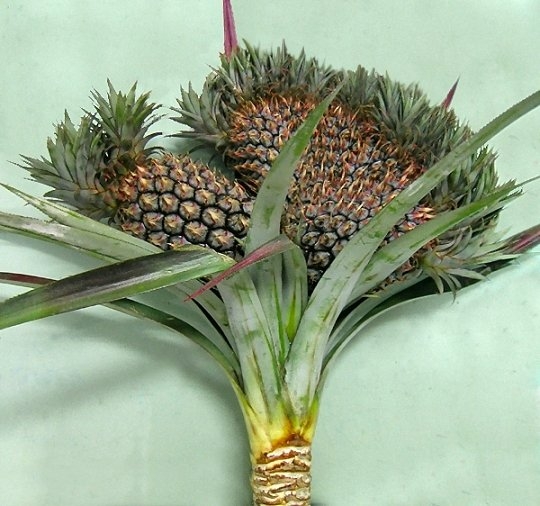Donate now to support the LLIFLE projects.
Your support is critical to our success.
Your support is critical to our success.
Accepted Scientific Name: Ananas comosus
Interpr. Herb. Amboin. 133. 1917

Ananas comosus f. cristatus Photo by: Valentino Vallicelli
Synonyms:
See all synonyms of Ananas comosus
back
Accepted name in llifle Database:Ananas comosus (L.) Merr.
Interpr. Herb. Amboin. 133. 1917
Synonymy: 91
- Ananas comosus (L.) Merr.
- Ananas ananas (L.) H.Karst.
- Ananassa ananas H.Karst.
- Bromelia ananas L.
- Ananas ananas var. albus (F.Cuvier)
- Ananas ananas var. flavus (Nois.)
- Ananas ananas var. giganteus (Nois.)
- Ananassa sativa var. gigantea (Nois.) Alef.
- Bromelia ananas var. gigantea Nois.
- Ananas ananas var. macrocarpus-violaceus (Nois.)
- Ananas ananas var. novus-macrocarpus (Nois.)
- Ananas ananas var. proliferus (Nois.)
- Bromelia ananas var. prolifera F.Cuvier
- Ananas ananas var. providentialis (Nois.)
- Ananas ananas var. rotundus (Nois.)
- Ananas ananas var. rubrus (Nois.)
- Ananas ananas var. viridis (Nois.)
- Ananassa sativa var. viridis (Nois.) Alef.
- Bromelia ananas var. viridis Nois.
- Ananas ananas var. vix-spinosus (Nois.)
- Ananas argentata J.C.Wendl. ex Schult. & Schult.f.
- Ananas aurata J.C.Wendl. ex Schult. & Schult.f.
- Ananas bracteatus Baker
- Ananas bracteatus var. hondurensis Bertoni
- Ananas bracteatus var. paraguayensis Bertoni
- Ananas coccineus Descourt.
- Ananas communis (Lamarck)
- Bromelia communis Lamarck
- Distiacanthus communis (Lamarck) Rojas Acosta
- Ananas comosus f. cristatus
- Ananas comosus var. variegatus (Nois.) Moldenke
- Ananassa sativa var. bicolor Alef.
- Ananassa sativa var. variegata Alef.
- Ananas sativus var. variegatus (Nois.) E.J.Lowe
- Bromelia ananas var. pyramidalis-variegata Nois.
- Bromelia ananas var. variegata Nois.
- Ananas debilis Schult. & Schult.f.
- Ananassa debilis Lindl.
- Ananas lyman-smithii Camargo
- Ananas mai-pouri (Perrier)
- Bromelia mai-pouri Perrier
- Ananas maxima Schult. & Schult.f.
- Ananas monstrosus (Carrière) L.B.Sm.
- Ananassa monstrosa Carrière
- Ananas ovatus Mill.
- Ananas pancheanus André
- Ananas penangensis hort. ex Baker
- Ananas pigna (Perrier)
- Bromelia pigna Perrier
- Ananas porteanus Veitch ex K.Koch
- Ananassa porteana (Veitch ex K.Koch) Carrière
- Ananas pyramidalis Mill.
- Ananassa sativa pyramidalis (Mill.) Alef.
- Bromelia ananas var. pyramidalis (Mill.) Nois.
- Ananas rubrus (hort. ex Schult.f.)
- Bromelia rubra hort. ex Schult.f.
- Ananas sativus (L.) Schult.f.
- Ananas comosus f. sativus Mez
- Ananassa sativa (L.) Lindl.
- Bromelia edulis Salisb.
- Ananas sativus var. durus (Alef.)
- Ananas sativus var. hispanorum Bertoni
- Ananas sativus var. milleri (Alef.)
- Ananas sativus var. muricatus Mez
- Ananas sativus var. pyramidalis Bertoni
- Ananas sativus var. rubrolineatus (Alef.)
- Ananas sativus var. testaceus (Alef.)
- Ananas serotinus Mill.
- Ananas violaceus (hort. ex Schult.f.)
- Bromelia violacea hort. ex Schult.f.
- Ananas viridis Mill.
- Ananas sativus var. viridis (Mill.) Bertoni
- Bromelia viridis (Mill.) hort. ex Schult.f.
back
| Your Actions | |
|---|---|
| Back to Ananas index | |
| Back to Bromeliaceae index | |
 |
Back to Bromeliads Encyclopedia index |







